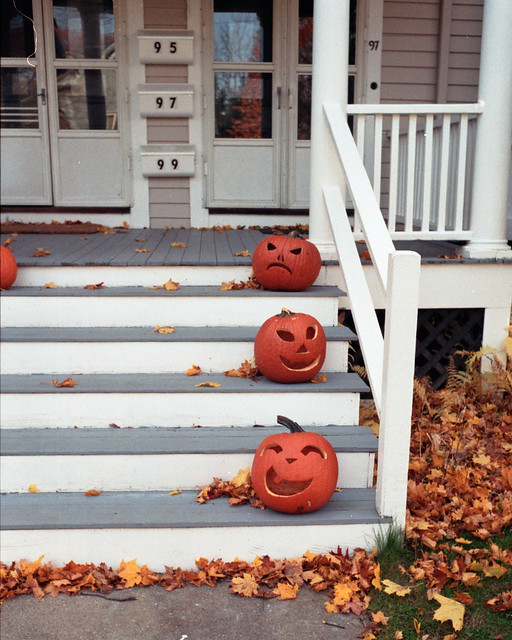Pumpkins of Concord, MA, by Reed A. George
Leica CL, Leica 3.5cm f3.5 Summaron Lens
Exposure Unrecorded
Mike Johnston of the Online Photographer has written about the most important challenge that he finds in shooting film - fixed, relatively low iso.
(Click Here) to read Mike's entry on the Online Photographer.
It is true - having the extra control of being able to adjust iso on the fly with digital cameras is a big plus. Especially when you can crank it up to iso 3200 or higher, and effectively shoot in the dark without a flash. Then, you can walk outside in midday sun, bring it down to iso 200 or lower, and go on your merry way. With film, you're effectively limited to iso 100 (okay, maybe 50) to iso 400 (or, in special cases, with quality tradeoffs, to 800 or even 3200). But, and this is key, you have to finish a roll of film before you can change to a different iso.
One response to Mike's piece made me think. Del Kimbler wrote:
"One of the things I liked about sheet film in my Century Graphic was that I could select by ASA one or two shots at a time...."
I never really thought of it before, but it's true. With a sheet film camera, each shot is independent, and you can carry a wide range of iso films loaded into single shot holders.
I also think about the fact that people, me included, have narrowed the range of application of film cameras to those that are easy with limited iso range. For example, I honestly can't remember the last time I used a flash on a film camera. I think it was perhaps New Year's Eve, 1999. There are two reasons for this. First, if I'm going somewhere dark enough to warrant carrying a flash, I'm not likely to take a film camera. Second, if I do need to use flash, digital allows me to tune in the amount of flash for the effect I want to achieve. That's much less risky than waiting to see "how they turned out" when my film is processed.
So maybe that's a new challenge for me - to shoot film in some situations that push the limits. Live with the use of very fast lenses and potential underexposure and blur. Try to use flash in a calculated way, rather than empirical (trial and error). Hmm. I'll have to think about that one. It does fit my current thought that in some cases, I'm willing to miss some of the shots for the chance of getting a really spectacular few.
DMC-365.blogspot.com

Hi Reed, I was searching for a way to use a flash with my medium format camera, without a light meter available. I've found an old rule, if you know the guide number for your flash you divide that for the distance in feet to the subject and you have the correct f-number.
ReplyDeleteHope this helps!
Hi Andrea,
ReplyDeleteI do remember this rule from my early photography days. You have to adjust it for the total distance the light travels if you bounce the flash. But, it's a good technique!
Reed
Great article Reed. It reminds me that one of the reasons I have issues with Lomo cameras is their lack of adequate exposure control, along with having to use flash with film in dim light. But then I see people using them anyway, experimenting and getting good results eventually. I like this challenge you've presented of shooting film only in difficult situations, might have to try it myself.
ReplyDeleteHi Joe - thanks for the comment! Gotta get out and try it...
DeleteReed
DMC-365.blogspot.com